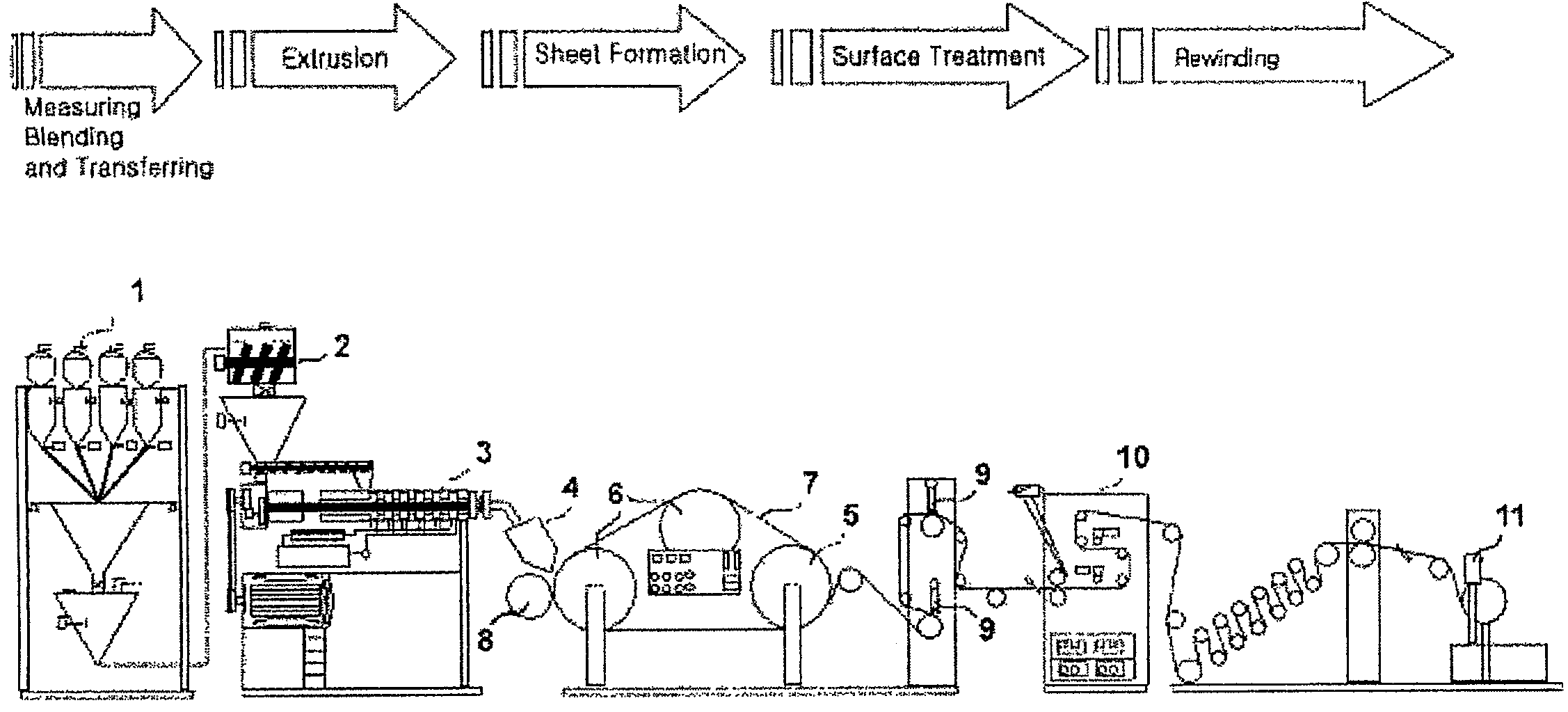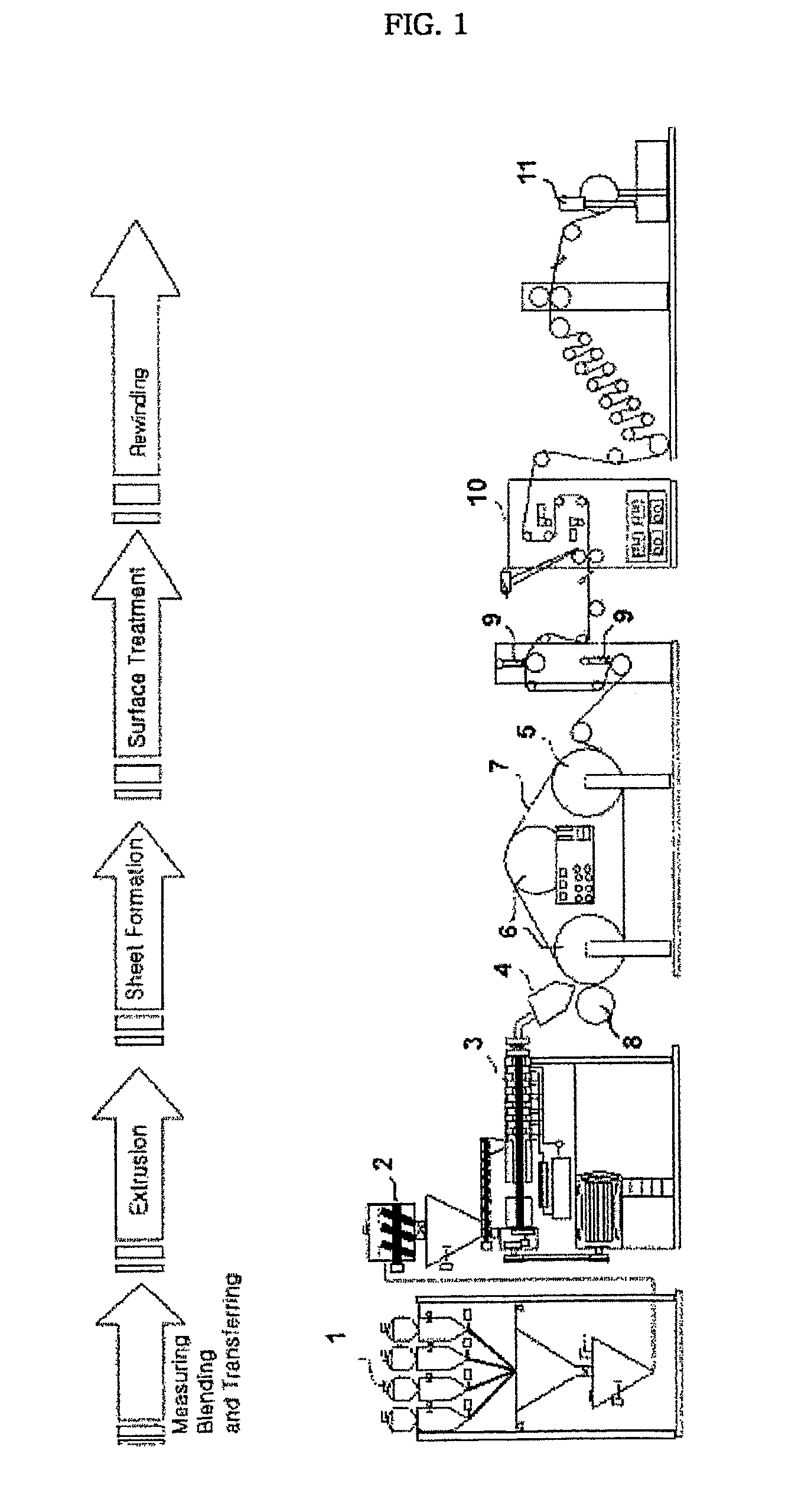Inkjet recording sheet
a technology of recording sheet and inkjet, applied in the field of inkjet recording sheet, can solve the problems of paper jamming, poor image quality upon continuous printing, resin coating paper, etc., and achieve the effect of imparting texture and same texture to print imag
- Summary
- Abstract
- Description
- Claims
- Application Information
AI Technical Summary
Benefits of technology
Problems solved by technology
Method used
Image
Examples
example 1
1-(1): Preparation of Support Film
[0058]40 parts by weight of polypropylene (H221P, SK Corp., Korea), 15 parts by weight of a propylene-ethylene random copolymer (R930Y, SK Corp., Korea), 10 parts by weight of a propylene-ethylene block copolymer (FT210, SK Corp., Korea), 10 parts by weight of TiO2 with an average particle size of 0.5 μm, 3 parts by weight of CaCO3, 2 parts by weight of talc, 9 parts by weight of high-density polyethylene, and 11 parts by weight of polystyrene were uniformly mixed in a blender and transferred to a hopper. A predetermined amount of a material blend was continuously transferred to an extruder from the hopper and then heated to about 210° C. with rotating at a rate of about 100 rpm in the extruder. The resultant molten blend was transferred to a T-die and ejected to a thickness of 200 μm by the T-die. The resultant ejection was allowed to pass between a forming roll with a canvas matte finish and a driving roll by a belt line. Then, the resultant film ...
example 2
2-(1): Preparation of Support Film
[0061]A support film was prepared in the form of a roll in the same manner as in Example 1-(1) except that the high-density polyethylene was used in an amount of 7 parts by weight, an ejection thickness was 230 μm by adjusting the gap of the T-die, and the corona treatment was performed at a voltage of 10,000V. The support film had a surface smoothness (for glossy surface) of 98% and a surface tension of 44 dyne.
2-(2): Formation of Primer Layer
[0062]A primer layer was formed in the same manner as in Example 1-(2) except that the thickness of the primer layer was adjusted to 3 μm using a knife.
2-(3): Formation of Ink Absorbing Layer
[0063]An ink absorbing layer was formed to a thickness of 40 μmin the same manner as in Example 1-(3).
2-(4): Formation of Back-Coating Layer
[0064]A back-coating layer was formed on an opposite surface to the glossy surface to prevent curling. The back-coating layer was formed as follows: 5 parts by weight of silica particl...
example 3
[0065]A recording sheet was manufactured in the same manner as in Example 1 except that a primer layer and an ink absorbing layer were sequentially coated on a canvas matte surface and then a top coating layer was formed on the ink absorbing layer. The top coating layer was formed to a thickness of 0.1 μm (on dry basis) by gravure coating using a mixed solution containing 3 parts by weight of silica particles with a particle size of 30 nm, 0.5 parts by weight of PVA (PVA 217, Kuraray), 50 parts by weight of water, and 50 parts by weight of methanol.
PUM
| Property | Measurement | Unit |
|---|---|---|
| viscosity | aaaaa | aaaaa |
| wt % | aaaaa | aaaaa |
| particle size | aaaaa | aaaaa |
Abstract
Description
Claims
Application Information
 Login to View More
Login to View More - R&D
- Intellectual Property
- Life Sciences
- Materials
- Tech Scout
- Unparalleled Data Quality
- Higher Quality Content
- 60% Fewer Hallucinations
Browse by: Latest US Patents, China's latest patents, Technical Efficacy Thesaurus, Application Domain, Technology Topic, Popular Technical Reports.
© 2025 PatSnap. All rights reserved.Legal|Privacy policy|Modern Slavery Act Transparency Statement|Sitemap|About US| Contact US: help@patsnap.com


